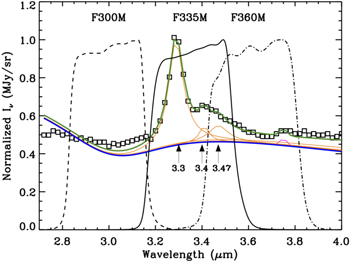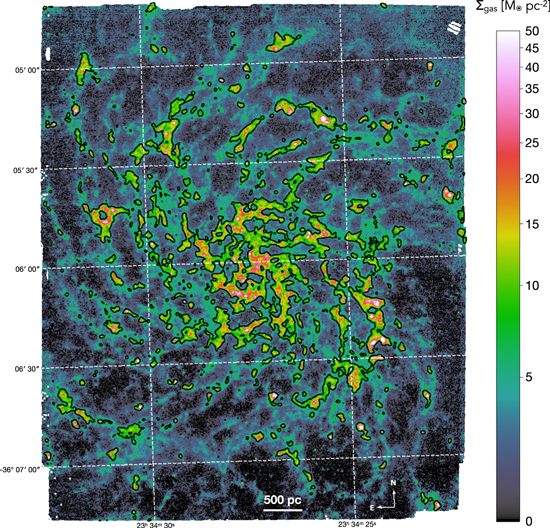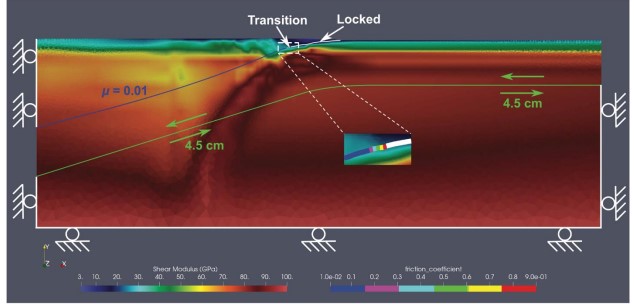- カリフォルニア大学サンディエゴ校の研究者たちが、最新鋭の望遠鏡を使って星間物質の最小の塵を研究
UC San Diego researchers use advanced telescope to study the smallest dust particles of the interstellar medium
- PHANGS-JWSTの最初の成果。NIRCam中バンドによる近傍銀河の3.3μm多環芳香族炭化水素振動帯のマッピング。 PHANGS–JWST First Results: Mapping the 3.3 μm Polycyclic Aromatic Hydrocarbon Vibrational Band in Nearby Galaxies with NIRCam Medium Bands
- PHANGS-JWSTの最初の成果:JWSTによる近傍銀河の多環芳香族炭化水素放射の撮像で、拡散性星間物質を追跡する。 PHANGS–JWST First Results: Tracing the Diffuse Interstellar Medium with JWST Imaging of Polycyclic Aromatic Hydrocarbon Emission in Nearby Galaxies
カリフォルニア大学サンディエゴ校の研究者たちが、最新鋭の望遠鏡を使って星間物質の最小の塵を研究 UC San Diego researchers use advanced telescope to study the smallest dust particles of the interstellar medium
2023-02-16 カリフォルニア大学サンディエゴ校(UCSD)
◆このたび、カリフォルニア大学サンディエゴ校の研究者たちは、世界中のプロジェクトチームと共同で、JWST第1サイクルのトレジャリープログラムによる先進的な望遠鏡画像を用いた研究成果を、『アストロフィジカルジャーナル・レターズ』の特別号で発表しました。
◆JWSTは非常に遠くの銀河を観測することができますが、サンドストーム教授のグループは約3000万光年という比較的近い距離にある、幻の銀河と呼ばれる銀河を研究しています。M74やNGC628としても知られている幻の銀河の存在は、少なくとも18世紀頃から天文学者が知っていました。
◆サンドストーム教授は、博士研究員のジェシカ・サッターと元博士研究員のジェレミー・シャステネ(現ゲント大学)と共に、多環芳香族炭化水素(PAHs)という宇宙空間に存在する特定の成分に注目した。PAHは分子サイズの小さな塵で、その小ささゆえに研究者にとって非常に価値のある物質です。
◆PAHは星からの光子を吸収すると振動し、中赤外域の電磁波で検出できる発光特性を示します。PAHの振動の特徴から、サイズ、イオン化、構造など多くの重要な特徴を観察することができます。
◆PAHは質量的に宇宙空間に占める割合はそれほど大きくありませんが、イオン化しやすく、光電子を発生させて宇宙空間の他のガスを加熱することができるため、重要な物質です。PAHをより深く理解することは、宇宙流体やその物理的な仕組みをより深く理解することにつながるでしょう。JWSTは、PAHがどのように形成され、どのように変化し、どのように破壊されるかを明らかにすることができると、宇宙物理学者たちは期待しています。
◆PAH は宇宙空間に均一に分布しているため、PAH 自体だけでなく、PAH の周りにあるすべてのものを見ることができるのです。スピッツァーで撮影されたこれまでの地図は、銀河の塊のようなもので、あまり詳細ではありませんでした。JWSTが提供する鮮明な画像によって、天体物理学者は、ガスフィラメントや、生まれたばかりの星が吹き出す「泡」まで見ることができるようになりました。
◆JWSTの観測時間を得るために、第1サイクルのトレジャリープログラムチームは、露出時間やフィルターなどの詳細を含む観測を設計する必要がありました。その後、JWSTの科学とミッションの運用を担当する宇宙望遠鏡科学研究所がデータを取得し、処理します。今回のプログラムでは、全部で19の銀河のデータが含まれています。
◆スピッツァー宇宙望遠鏡 (l) と JWST (r) で撮影された NGC 628 (幻の銀河) の画像を並べて比較したところ、透明度と詳細度が著しく向上していることが分かりました。(SST cr: NASA/JPL-CalTech; JWST cr: NASA, ESA, CSA, STScI)
第1サイクルのトレジャリープログラムは、PHANGS (Physics at High Angular Resolution in Nearby GalaxieS) と呼ばれる大きなプロジェクトの一部である。PHANGSは、チリにあるアタカマ大型ミリ波干渉計(ALMA)と超大型望遠鏡の多波長画像を使って、星形成と宇宙空間を研究しています。しかし、星形成が起こる高密度の雲は多くのダストを含んでいるため、光学的な光を透過して内部で何が起こっているかを見ることは困難です。中間赤外線を使えば、その塵の明るい発光を利用して、高解像度で詳細な画像を得ることができるのです。
<関連情報>
- https://today.ucsd.edu/story/jwst-interstellar-medium
- https://iopscience.iop.org/article/10.3847/2041-8213/acb0cf
- https://iopscience.iop.org/article/10.3847/2041-8213/aca972
PHANGS-JWSTの最初の成果。NIRCam中バンドによる近傍銀河の3.3μm多環芳香族炭化水素振動帯のマッピング。 PHANGS–JWST First Results: Mapping the 3.3 μm Polycyclic Aromatic Hydrocarbon Vibrational Band in Nearby Galaxies with NIRCam Medium Bands
Karin M. Sandstrom, Jérémy Chastenet, Jessica Sutter, Adam K. Leroy, Oleg V. Egorov, Thomas G. Williams, Alberto D. Bolatto, Médéric Boquien, Yixian Cao, Daniel A. Dale, Janice C. Lee, Erik Rosolowsky, Eva Schinnerer, Ashley. T. Barnes, Francesco Belfiore, F. Bigiel, Mélanie Chevance, Kathryn Grasha, Brent Groves, Hamid Hassani, Annie Hughes, Ralf S. Klessen, J. M. Diederik Kruijssen, Kirsten L. Larson, Daizhong Liu, Laura A. Lopez, Sharon E. Meidt, Eric J. Murphy, Mattia C. Sormani, David A. Thilker and Elizabeth J. Watkins
The Astrophysical Journal Letters Published 2023 February 16
DOI:10.3847/2041-8213/acb0cf

Abstract
We present maps of the 3.3 μm polycyclic aromatic hydrocarbon (PAH) emission feature in NGC 628, NGC 1365, and NGC 7496 as observed with the Near-Infrared Camera imager on JWST from the PHANGS–JWST Cycle 1 Treasury project. We create maps that isolate the 3.3 μm PAH feature in the F335M filter (F335MPAH) using combinations of the F300M and F360M filters for removal of starlight continuum. This continuum removal is complicated by contamination of the F360M by PAH emission and variations in the stellar spectral energy distribution slopes between 3.0 and 3.6 μm. We modify the empirical prescription from Lai et al. to remove the starlight continuum in our highly resolved galaxies, which have a range of starlight- and PAH-dominated lines of sight. Analyzing radially binned profiles of the F335MPAH emission, we find that between 5% and 65% of the F335M intensity comes from the 3.3 μm feature within the inner 0.5 r25 of our targets. This percentage systematically varies from galaxy to galaxy and shows radial trends within the galaxies related to each galaxy’s distribution of stellar mass, interstellar medium, and star formation. The 3.3 μm emission is well correlated with the 11.3 μm PAH feature traced with the MIRI F1130W filter, as is expected, since both features arise from C–H vibrational modes. The average F335MPAH/F1130W ratio agrees with the predictions of recent models by Draine et al. for PAHs with size and charge distributions shifted toward larger grains with normal or higher ionization.
PHANGS-JWSTの最初の成果:JWSTによる近傍銀河の多環芳香族炭化水素放射の撮像で、拡散性星間物質を追跡する。 PHANGS–JWST First Results: Tracing the Diffuse Interstellar Medium with JWST Imaging of Polycyclic Aromatic Hydrocarbon Emission in Nearby Galaxies
Karin M. Sandstrom, Eric W. Koch, Adam K. Leroy, Erik Rosolowsky, Eric Emsellem, Rowan J. Smith, Oleg V. Egorov, Thomas G. Williams, Kirsten L. Larson, Janice C. Lee, Eva Schinnerer, David A. Thilker, Ashley T. Barnes, Francesco Belfiore, F. Bigiel, Guillermo A. Blanc, Alberto D. Bolatto, Médéric Boquien, Yixian Cao, Jérémy Chastenet, Mélanie Chevance, I-Da Chiang (江宜達), Daniel A. Dale, Christopher M. Faesi, Simon C. O. Glover, Kathryn Grasha, Brent Groves, Hamid Hassani, Jonathan D. Henshaw, Annie Hughes, Jaeyeon Kim, Ralf S. Klessen, Kathryn Kreckel, J. M. Diederik Kruijssen, Laura A. Lopez, Daizhong Liu, Sharon E. Meidt, Eric J. Murphy, Hsi-An Pan, Miguel Querejeta, Toshiki Saito, Amy Sardone, Mattia C. Sormani, Jessica Sutter, Antonio Usero and Elizabeth J. Watkins
The Astrophysical Journal Letters Published 2023 February 16
DOI:10.3847/2041-8213/aca972

Abstract
JWST observations of polycyclic aromatic hydrocarbon (PAH) emission provide some of the deepest and highest resolution views of the cold interstellar medium (ISM) in nearby galaxies. If PAHs are well mixed with the atomic and molecular gas and illuminated by the average diffuse interstellar radiation field, PAH emission may provide an approximately linear, high-resolution, high-sensitivity tracer of diffuse gas surface density. We present a pilot study that explores using PAH emission in this way based on Mid-Infrared Instrument observations of IC 5332, NGC 628, NGC 1365, and NGC 7496 from the Physics at High Angular resolution in Nearby GalaxieS-JWST Treasury. Using scaling relationships calibrated in Leroy et al., scaled F1130W provides 10–40 pc resolution and 3σ sensitivity of Σgas ∼ 2 M⊙ pc−2. We characterize the surface densities of structures seen at <7 M⊙ pc−2 in our targets, where we expect the gas to be H i-dominated. We highlight the existence of filaments, interarm emission, and holes in the diffuse ISM at these low surface densities. Below ∼10 M⊙ pc−2 for NGC 628, NGC 1365, and NGC 7496 the gas distribution shows a “Swiss cheese”-like topology due to holes and bubbles pervading the relatively smooth distribution of the diffuse ISM. Comparing to recent galaxy simulations, we observe similar topology for the low-surface-density gas, though with notable variations between simulations with different setups and resolution. Such a comparison of high-resolution, low-surface-density gas with simulations is not possible with existing atomic and molecular gas maps, highlighting the unique power of JWST maps of PAH emission.



